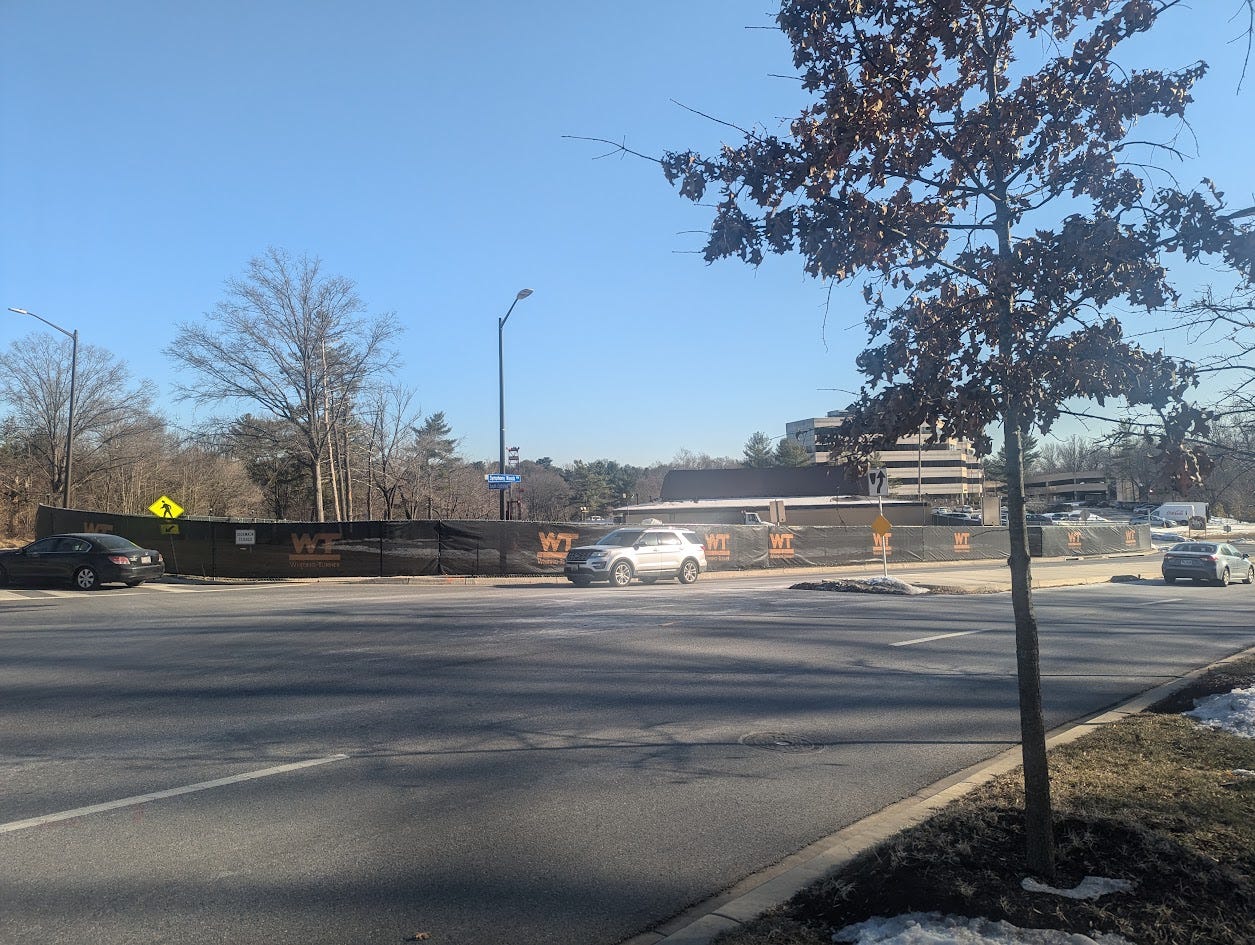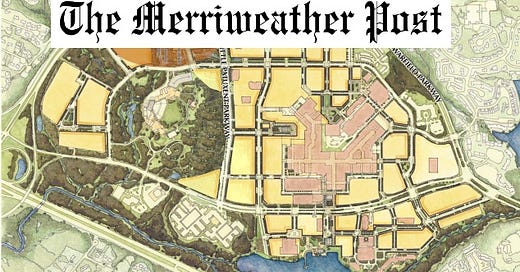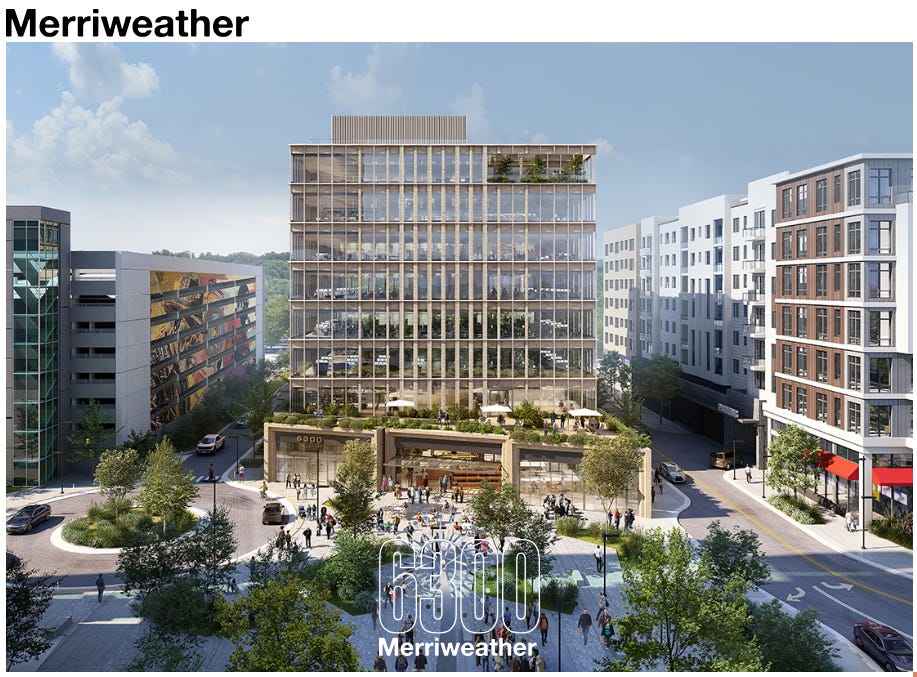The Merriweather Post - February 2025 Edition
Will Gateway Pay Off?, The W.R. Grace Plastic Recycling Controversy, The New Cultural Center Construction Mystery, New Bike Infrastructure Projects, School Redistricting, & New Merriweather Map
Will the County Investment in Gateway Pay off?
Howard County revealed their preferred master plan for Columbia Gateway on January 22, 2025. The desired transformation draws from design elements of the three options the County previously put forward for community feedback to remake the sprawling 1,000 acre office park into a dense neighborhood that “prioritizes walkability and community spaces while integrating seven-story buildings, retail and dining areas, and mixed-used development.” The County wagers that by investing in the infrastructure needs (new entrance roads, street grids, bike/ped improvements, parking, parks, schools, public safety, fire, water/sewer, etc.), the area will become a “hub for employment, innovation, and entertainment that attracts industries like cybersecurity, medical research, and government contracting while addressing the growing need for affordable housing and creating opportunities for small-businesses.”
The County has a designated website for it’s Gateway Plan with lots of information, and multiple news outlets have covered the story (including mine), so I won’t rehash the details here and instead point to the news coverage of the latest announcement:
Amazon didn’t want Columbia Gateway, so Howard County has a new people-friendly plan. Lillian Reed for Baltimore Banner, January 25, 2025.
Howard County plans to turn an aging office park into a tech hub, Matt Hooke for the Baltimore Business Journal, January 23, 2025.
Public meeting to unveil Howard County’s Gateway Master Plan, Aliza Worthington for Baltimore Fishbowl, January 14, 2025
I found the County’s materials to be heavy on design and land-use plans, while light on economics/finances, a topic I expect to become a point of contention when the County Council takes up the master plan for review and adoption later this Spring or Summer.
It cannot be stressed enough that this is a 30-year plan, the success, in my opinion and if measured in terms of net revenue creation for the County, hinges nearly entirely on the ability to attract employers/industries to locate in the area. The County will need to make a significant investment in public infrastructure improvements to transform the area in hopes that a redesigned Gateway will attract major employers in fast-growing industries who will invest in property improvements. Tax-paying businesses, tax-paying real estate, tax-paying employees, tax-paying residents. Jobs, housing, small-business opportunities and new retail/restaurant/entertainment options are all positive outcomes of a realized Gateway plan, but if the success of Gateway is going to be measured by how much new net tax revenue is brought into the County, one cannot stress enough how important it is for the area to become a major employment center. Create new jobs, and the tax dollars will follow.
To that end, Howard County has designated Gateway and Route 1 corridor as a enterprise zone as part of the MD Enterprise Zone program. Companies coming to Gateway will be entitled to significant tax incentives. Eligible businesses may claim a 10-year credit against property taxes equal to 80% of assessed property improvements for the first 5-years and then decreasing by 10% annually until the credit is 30% in the 10th year. Thereafter, the business will pay regular property tax rates. Under this program, the State reimburses the County for half of the lost tax revenue. Additionally, eligible businesses can claim a $1000 per employee credit for wages paid to new employees. This designation and tax credit scheme were passed by the County Council in Fall 2024 via a 3-2 vote (CR-134-2024, Yes: Rigby, Jones, Yungmann; No: Walsh, Jung).
The Gateway strategy appears to be: Establish a land-use plan, invest in public improvements (likely through new debt issuance collateralized by future Gateway tax revenue), lure companies with tax-incentives, and ultimately, profit, but only once those tax incentives expire and debt issuances are paid off. Did I mention this a 30-year plan. Hope it works!
Plastics, Plastics, Plastics
W.R. Grace, the 150-year old chemical company headquartered on Grace Drive, has become the subject of significant community backlash for its proposal to launch a plastics recycling pilot program at its facility. Nearby residents fear the processes involved will result in chemical emissions that are harmful to human health and safety, and are especially concerned given the close proximity of W.R. Grace to the adjacent Cedar Creek community, which was built 5 years ago on land that W.R. Grace itself had owned and sold off for residential development (See: Good Development or Bad?: Cedar Creek along Grace Drive, June 23, 2020, The Merriweather Post). The uproar has intensified this past week as hundreds of residents spoke out at a public hearing on February 18th and 19th for Council Bill 11-2025 (ZRA-211), introduced by D4 councilmember Deb Jung to modify zoning laws in a way that would prevent the pilot program.
For it’s part, W.R. Grace has set up a website to counter “misinformation” and explain that the small-scale pilot (to be conducted in an existing building the size of a one-car garage) will study an innovative environmental-friendly method for plastic-recycling that involves no burning nor incinerating of plastics and will have no impact on the health or wellbeing of the local community or the employees who work at the facility. They note that the laboratory is for research only, and if they were to ever scale up this process for production, it would not be at their Columbia site. The pilot would be run upon approval and in full compliance with Maryland Department of the Environment requirements on air quality and emission evaluations. In a letter posted on their website, W.R. Grace contends that the Council bill is “a reckless misuse of zoning laws”, “puts politics over science”, and would ultimately “mar Howard County’s reputation as a hub for research, innovation, and technology” (see the Gateway story above about Howard County seeking to attract said industries).
Certainly, there is no acceptable risk levels when it comes to people’s health. But W.R. Grace claims there is no risk. Nonetheless, residents certainly have reason to be skeptical given the company’s track record of past controversial incidents involving asbestos and water contamination. The star-studded 1998 film A Civil Action is based on W.R. Grace contamination of drinking water in Woburn, Massachusetts in the 1980s. The legal drama tells the story of how local residents fought back against (this very same) corporation that was found to be polluting their town, poisoning their children, and then lying about it, and this true story is undoubtably inspiring some of the mistrust and outrage being expressed by Columbia residents today. On the other hand, is it reasonable to change local zoning laws to no longer allow a permitted use subject to Maryland environmental regulations because of actions taken over 40 years ago by a bankrupted precedent company operating in a different era under different leadership as depicted in a Hollywood film starring John Travolta, Robert Duvall, William H. Macy, John Lithgow, James Gandolfini, and Kathy Bates (uncredited)? How’s that for a sentence?! We will find out whether the council bill passes as soon as the Council’s March 3, 2025 legislative meeting.
To My Surprise, the New Cultural Center Breaks Ground
When Howard County Executive Dr. Calvin Ball announced back in November that the County was moving ahead with the the New Cultural Center in Downtown Columbia, I maintained a healthy degree of skepticism that it would actually happen. After all, it’s been over 4 years since $55 million of funding for the project was debated and ultimately approved by the Howard County Council, but in the time since, the project has had multiple false starts, delays and underfunding issues. But alas, it appears that the County Executive was not bluffing, as evident by the fencing that has been installed surrounding Toby’s Dinner Theater signaling the commencement of construction. Oh happy day!

And while it’s now clear that the new New Cultural Center is actually being built, questions of what is actually being built still remain. We know the project will combine 174 housing units (dubbed Artist’s Flats) above an arts and cultural center that include a new home for Toby’s Dinner Theater, two new black-box theaters, classrooms, galleries, and studio spaces. What we don’t know is the final cost or the final design. Last we heard, the County was investigating ways to either redesign the center to reduce the construction costs and/or find additional sources of funding, but none of these new details have been revealed yet.
Has the project been redesigned from original plans/renderings? If so, in which way? Are there new renderings?
What’s the final price tag?
Was the County successful in securing other sources of funding? If so, what?
Will the center have all the amenities that were originally part of original renderings, including a grand 2-story lobby, a huge rooftop terrace, a cafe, a fishbowl dance studio?
What’s the final square footage of arts/cultural space and how does it compare to the original plan?
I reached out to the County Executive’s Office and confirmed that no new details have been revealed and that a more formal announcement is slated for April, so I am anticipating answers to these questions soon.
New Howard County Bike and Pedestrian Projects Announced
On January 30, 2025; The Howard County Office of Transportation held their annual Open House to present new and upcoming bike and pedestrian projects, public transit, road safety, public works, and other local/regional transportation plans.
Open House Materials are available on the 2025 Transportation Open House website, and include detailed descriptions and maps. Most notably to me are 3 (of the 66 planned County-wide) bike and pedestrian improvement projects in the Downtown Columbia and Hickory Ridge area:
Hickory Ridge Road Pathway: Pathway on the southside of Hickory Ridge Road between Martin and Broken Land Parkway including a connection to the Sebring pathway and pedestrian crossing of Martin Road.
South Entrance Trail: Connection from South Entrance Road / Merriweather District to Steven Forest Road passing under US29 and Broken Land Parkway.
Cedar Lane: Upgrades to existing pathway on Cedar Lane between Little Patuxent Parkway and Harpers Farm Road. Feasibility Study for lane reconfiguration to improve multimodal safety on Cedar Lane between Owen Brown Road and Sanner Road (e.g. consideration of the Oakland Mills Road treatment).

School Board initiates School Redistricting Boundary Review Process
During the February 13, 2025 Board of Education meeting, the school board unanimously approved the initiation of a boundary review process to occur during the 2025 calendar year to address schools that are outside the capacity utilization range of 90% to 110%. The attendance area adjustment process will include Bryant Woods, Running Brook, Swansfield, Clemens Crossing, and Centennial Lane Elementary Schools. Wilde Lake, Harper’s Choice, and Burleigh Manor Middle Schools and Centennial and Wilde Lake High Schools will also be included to allow adjustments to feeds. The plan will be implemented for school year 2026/27.
Some of these schools are significantly underutilized whereas others are significantly overcapacity, so a solution the school system is suggesting is to redistrict students from over-enrolled Bryant Woods to under-enrolled Swansfield and Longfellow; and similarly, move Centennial Lane students to Manor Hill, while considering corresponding moves at the middle and high school level to maintain strong feeds. Given that the total number of students enrolled in Howard County public schools has not increased (and in fact, it has decreased) since the last redistricting 5 years ago, the need to revisit the boundary areas for schools that were significantly upended by the 2019 redistricting is a clear admission that the rushed nature and lack of foresight that occurred towards the end of the last redistricting process lead to poor decisions that now need to be corrected.
New Merriweather District Leasing Map
A new retail site plan of the Merriweather District was uploaded to the HR Retail website on February 18, 2025. Pinnacle Financial and Paws Up Veterinarian have leased space in Juniper along Merriweather Drive. Visible interior progress and signage up at Eggspectation, Mighty Quinn’s BBQ, and Gyu San Japanese BBQ indicate they are all getting closer to opening. Only a handful of vacancies remain in Juniper and Marlow. Further phases of the Merriweather District build-out will bring new retail on the ground floor of office and/or residential buildings, though as discussed in my January 2025 update, none of these will commence in 2025, and the Merriweather project next on deck, 6300 Merriweather, will now be half the size of what was originally announced.







I always appreciate you sharing what's going on with the community construction. Have you heard about what will happen with Bark Social, yet?
Neat to see the proposed pedestrian connectivity from Stevens Forest Road down into Merriweather. I live right near BLP and SFR, but despite being quite close as the crow flies there’s not currently a great way to get there without hopping in the car for three minutes.